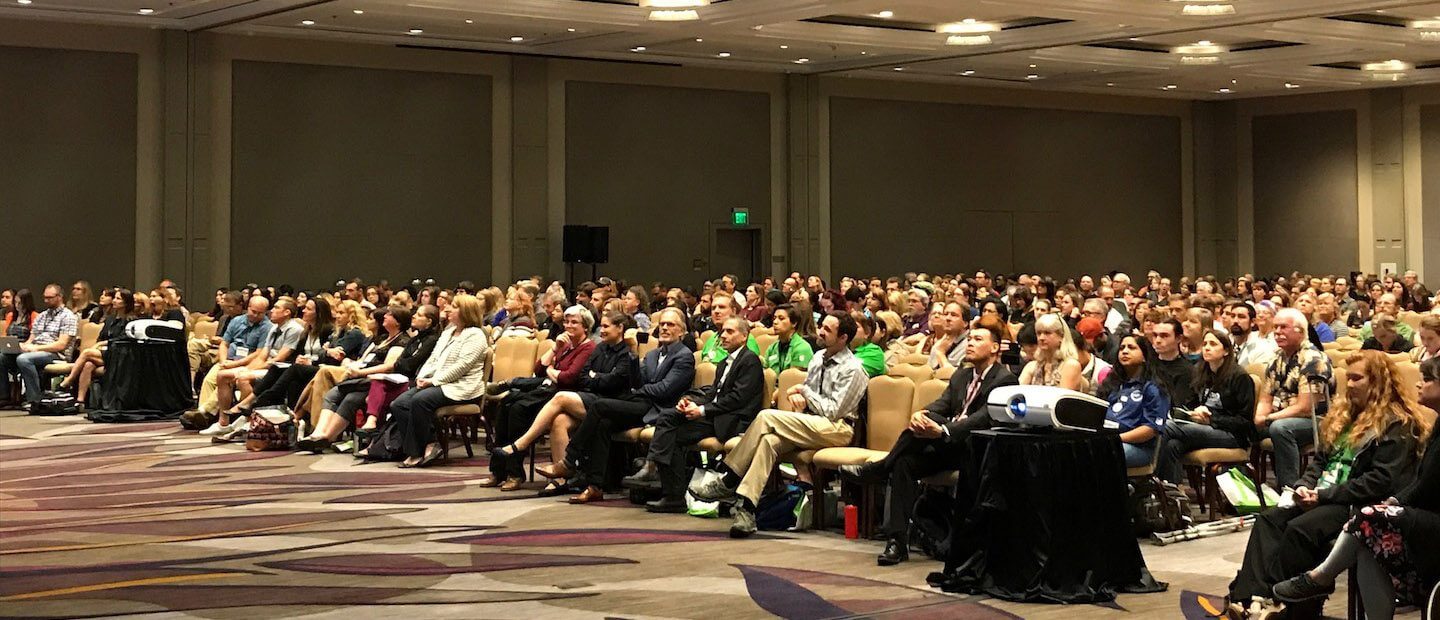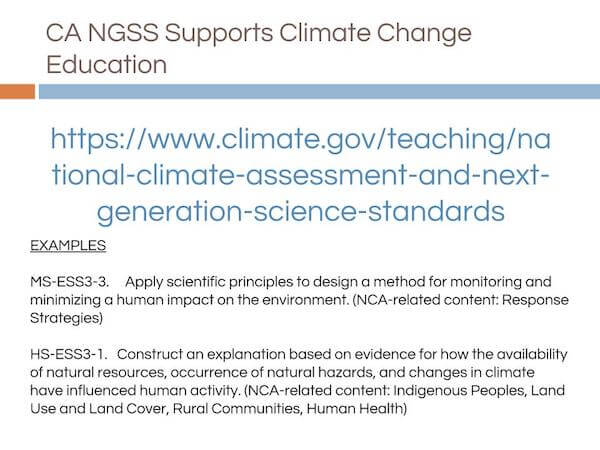The following are excerpts from the keynote address Terry Tamminen, CEO of the Leonardo DiCaprio Foundation, gave at the California Science Teachers Association 2017 Conference in Sacramento on Friday, October 13, 2017.
The Leonardo DiCaprio Foundation (LDF) is working around the globe on species protection and conservation issues, climate change, and empowering indigenous and local activists. But nothing we do is more important than advancing the cause of ecoliteracy.
All of the environmental challenges we face have one thing in common: they are caused by environmental illiteracy. But I also believe that these problems can be fought with a secret weapon: all of you!
Since the first Earth Day in 1970, governments and non-governmental organizations have spent countless hours and billions of dollars to try to educate the public via the news media and other information channels, field trips outside of the classroom, documentaries, and museum exhibits. Yet so far, this investment has made very little difference in slowing down the march of devastating climate change impacts and the loss of natural habitat and species. In part this is because up to now great environmental education efforts and programs have been very well researched, documented, and scientifically sound, but overall remain uncoordinated.
To get lasting and large-scale change, we need to turn the tide in America and beyond. We need to combine these programs—like so many oars rowing the boat in the same direction to make it go faster and not just in circles—and take them directly to the decision-makers of the future: our students in public schools. There are no shortcuts.
That’s why LDF has chosen to invest in organizations working with the State of California, because we believe California has unique tools to assist teachers in teaching science using the environment for context and we know that environmental literacy and science are inextricably intertwined. Moreover, science teachers in California have influence beyond their classrooms and even beyond their state. I have seen first-hand how California is an environmental leader in the US and around the world. As you know, California is the sixth-largest economy in the world with the largest population of any US state—over 12% of the entire country lives here—and the biggest school system with over 6 million public school students, producing about 400,000 graduates each year who go out into the world and begin to influence others.
We believe, as I’m sure you do, students who are environmentally literate will make informed decisions as consumers and voters, be better stewards of their own environment, and will be equipped to take advantage of green STEM-related job opportunities.
One example of this is Leonardo DiCaprio. He was inspired as a young boy by the things he learned about nature in science class at school in Los Angeles. He credits his childhood teachers with helping instill in him a passion to protect the environment (oh yes, and to go into acting).
And my connection to science education and environmental literacy in California is also personal. Supporting the implementation of former Senator Fran Pavley’s Education and the Environment Initiative law is how I met my wife Leslie, one of the architects of that law!
The importance of environmental literacy may best be illustrated by the level of illiteracy that exists around climate change, and the very real impacts to the planet and economy that result. California teachers are especially critical in helping students understand climate change and to fundamentally alter this dynamic. Today only 45% of American adults think climate change is a “very serious problem” and in China, which is the world’s top greenhouse gas polluter after the US, barely 18% classify climate change as an issue.
But who can blame people who have not been educated about how these issues relate to them and their families—and if they are motivated to take action how to be good stewards of the environment, how to make informed choices, or how to elect leaders who understand science and will base their policies on facts?

I need not tell you that climate scientists warned us for decades that increased warming of the planet caused by our carbon emissions would result by the early 21st century in things such as more severe and damaging storms, longer-lasting droughts, and year-round wildfires. Indeed, 2017 will set new records for all of those predictions and the breathtaking toll on human life ecosystems and the economy—all because we failed to heed the science and take action sooner.
Which raises the question of why? In addition to a general lack of climate science taught in schools or to decision-makers in all walks of life, we are also up against the climate-denial industry that is pouring millions of dollars into the education system in states across the country—a denial industry that is emboldened by the Trump administration which is empowering people and policies that openly question the truth and urgency of climate science predictions.
It’s therefore more important than ever that California continues to lead the nation in its commitment to having a science, civics, and environmentally literate population, especially as coordinated anti-science policy across the country is a growing threat which is the result of a very simple three-part strategy by climate deniers: Money + Media = Laws.
- Money: A 2013 study by Drexel University found that 140 foundations funneled $558 million to almost 100 climate-denial organizations from 2003 to 2010. I recommend you read Dark Money by Jane Mayer for much more information on the resources lined up against science and common sense.
- Media: Money is pumped into conservative-leaning news media like Breitbart and National Review to question the consensus science of climate change.
- Laws: And that combination of deep, dark pockets plus misleading media leads to voters and lawmakers who are fooled or emboldened to take the nation backwards. For example, the fossil-fuel funded American Legislative Exchange Commission, better known as ALEC, has been drafting anti-science bills for decades—such as the dubiously named “Environmental Literacy Improvement Act.” Language from these sample pieces of legislation has been used by biased lawmakers around the country.
Perhaps the most terrifying aspect of the laws drafted from these examples is their vagueness. The language of bills in Oklahoma, Indiana, Alabama, Idaho, and Texas includes terms like “academic freedom” and “controversial subjects” to disguise the true purpose of these laws, which is to give educators permission to stray from established peer-reviewed science on climate change and evolution toward theories that align more with their personal ideologies but are not based in science. If passed, these types of laws undo much of the hard work being done in states to get the Next Generation Science Standards adopted.
And lest you think that legislative templates don’t become actual laws let me give you just two examples.
- Last May the Alabama Senate voted to adopt House Joint Resolution 78 which empowers state and local education authorities to promote the “academic freedom” of science teachers in the state’s public schools to say that “Biological evolution, the chemical origins of life, global warming, and human cloning” are considered “controversial.”
- And New Mexico’s Public Education Department recently unveiled a proposed replacement to its statewide science standards, including guidelines to minimize teaching of the rise in global temperatures, remove references to human activity as the primary driver of climate change, remove or weaken the mere mention of evolution, and remove references to the actual age of the Earth as being 4.6 billion years!
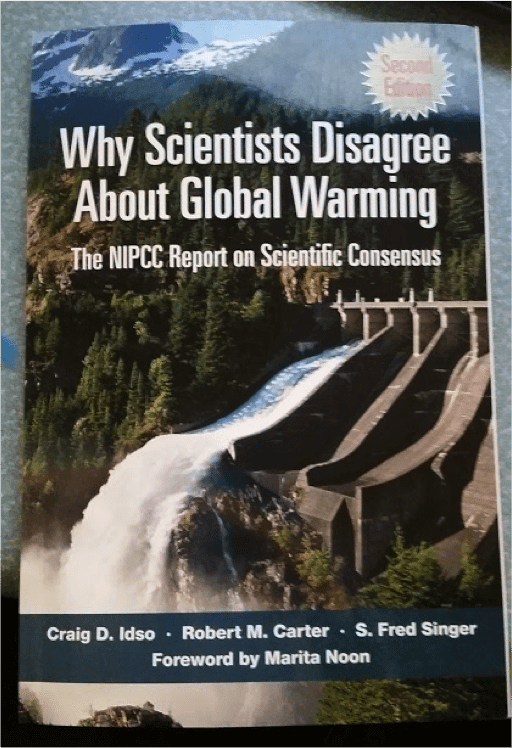 And now this blending of money and media has gone in another direction even more direct and insidious. This year the climate misinformation movement is directly contacting teachers. Here’s a recent mailing by the Heartland Institute, its report entitled, “Why Scientists Disagree About Global Warming,” sent to 200,000 teachers across the US. Of course there is no real disagreement when the world’s scientists under the Intergovernmental Panel on Climate Change have concluded with more than 99% certainty that climate change is real and humans are the primary cause. In fact it’s hard to find almost any other scientific endeavor that has more consensus around those facts except perhaps that the world is no longer thought to be flat!
And now this blending of money and media has gone in another direction even more direct and insidious. This year the climate misinformation movement is directly contacting teachers. Here’s a recent mailing by the Heartland Institute, its report entitled, “Why Scientists Disagree About Global Warming,” sent to 200,000 teachers across the US. Of course there is no real disagreement when the world’s scientists under the Intergovernmental Panel on Climate Change have concluded with more than 99% certainty that climate change is real and humans are the primary cause. In fact it’s hard to find almost any other scientific endeavor that has more consensus around those facts except perhaps that the world is no longer thought to be flat!
It’s worth spending a few moments on the disinformation campaign of the Heartland Institute because you need to recognize the difference between propaganda and valuable supplemental materials you might receive. The Heartland Institute is spending an estimated $3 million to $6 million on a direct-mail marketing campaign to get this professionally-produced junk science publication into the hands of public school teachers who teach science in the US. The look and feel of this bogus report is very similar to the front covers of science instructional materials, even California’s own Education and the Environment Initiative Curriculum.
But while I’m sure you are all too smart for that, unfortunately many of your peers in other states are led astray. An independent report commissioned by Scholastic on the preferences of teachers in using supplemental education materials states that a whopping 8 out of 10 teachers will open and evaluate unsolicited teaching materials. A report last year in Science showed that just barely half of US science teachers teach that humans are responsible for climate change, and at least a third give mixed messages to students suggesting that scientists believe that natural factors are responsible.
Why? Well, one answer might be found in a new study published in the Proceedings of the National Academies of Science which says that religious and political beliefs override education when it comes to accepting the mainstream science of climate change.
Given all this, what can we do? What can you do to teach science in the face of such well-funded misinformation? There are many reasons for hope in California:
- The National Science Teachers Association encourages science teachers to send them the unsolicited propaganda from the Heartland Institute and they will recycle it! In return teachers will receive free access to their ebook, Ocean’s Effect on Weather and Climate. And, we commend CSTA for its position on Climate Change.
- To further combat misinformation, the Alliance for Climate Education has resources and plans to roll out lesson plans and in-class activities to accompany new video resources to support teachers in this area, as well as a “rapid response” curriculum to support teachers to teach climate in areas of the country that were recently hit by hurricanes and other climate-related events as they unfold.
- And even more significantly, California’s Next Generation Science Standards (CA-NGSS) support climate change education, and this position is further reinforced by the presence of California’s Environmental Principles and Concepts (EP&Cs) in the new Science Framework. This means that as educators you do not need to hold back on teaching students about how human activities affect global warming, and that decisions to reduce the impacts of global warming depend on understanding climate science, engineering capabilities, and social dynamics.
- These EP&Cs are unique to California and were created as a result of the 2003 passage of California’s Education and the Environment Initiative Law. They examine the interdependence of human societies and natural systems and appreciate systems thinking and the connection and interdependence between humans and their environment.
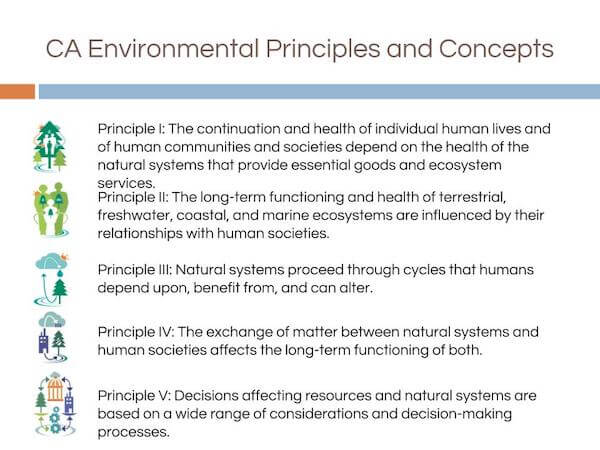
 These EP&Cs have been integrated into the 2016 Science Framework and 2016 History–Social Science Framework, and will significantly be integrated into the science and history–social science instructional materials during the next adoption. The California Department of Education also engaged a multiyear, multistakeholder process to develop California’s Blueprint for Environmental Literacy.
These EP&Cs have been integrated into the 2016 Science Framework and 2016 History–Social Science Framework, and will significantly be integrated into the science and history–social science instructional materials during the next adoption. The California Department of Education also engaged a multiyear, multistakeholder process to develop California’s Blueprint for Environmental Literacy.
Superintendent Tom Torlakson appointed the Environmental Literacy Steering Committee to implement the Blueprint statewide. LDF knows that EP&Cs, committees, and you educators won’t accomplish the goal of ecoliteracy alone, so that’s why we are proud to work with non-government organizations like Ten Strands, TreePeople, and others who are partnering with state agencies and state public schools.
It’s also why we have committed $3 million over three years to help all of you achieve the vision for true, widespread environmental literacy. Those funds support teaching science in the context of the environment by providing professional development focusing on school districts as the unit of change, linking nonformal providers of environmental education and green employers to schools, and helping districts access funding.
Does this approach work? Take for example Katherin Konomi (4th Grade Teacher), from the Burlingame School District, who said, “My biggest accomplishment as a teacher was learning how to take students outside of the classroom to work on science. It is the biggest learning experience you can offer your students. I was able to comprehend that you don’t need a big and elaborate lesson to take students outside. Taking students into their environment to observe dirt and rocks can have such a huge impact on fostering the relationship of your students to the world of science.”
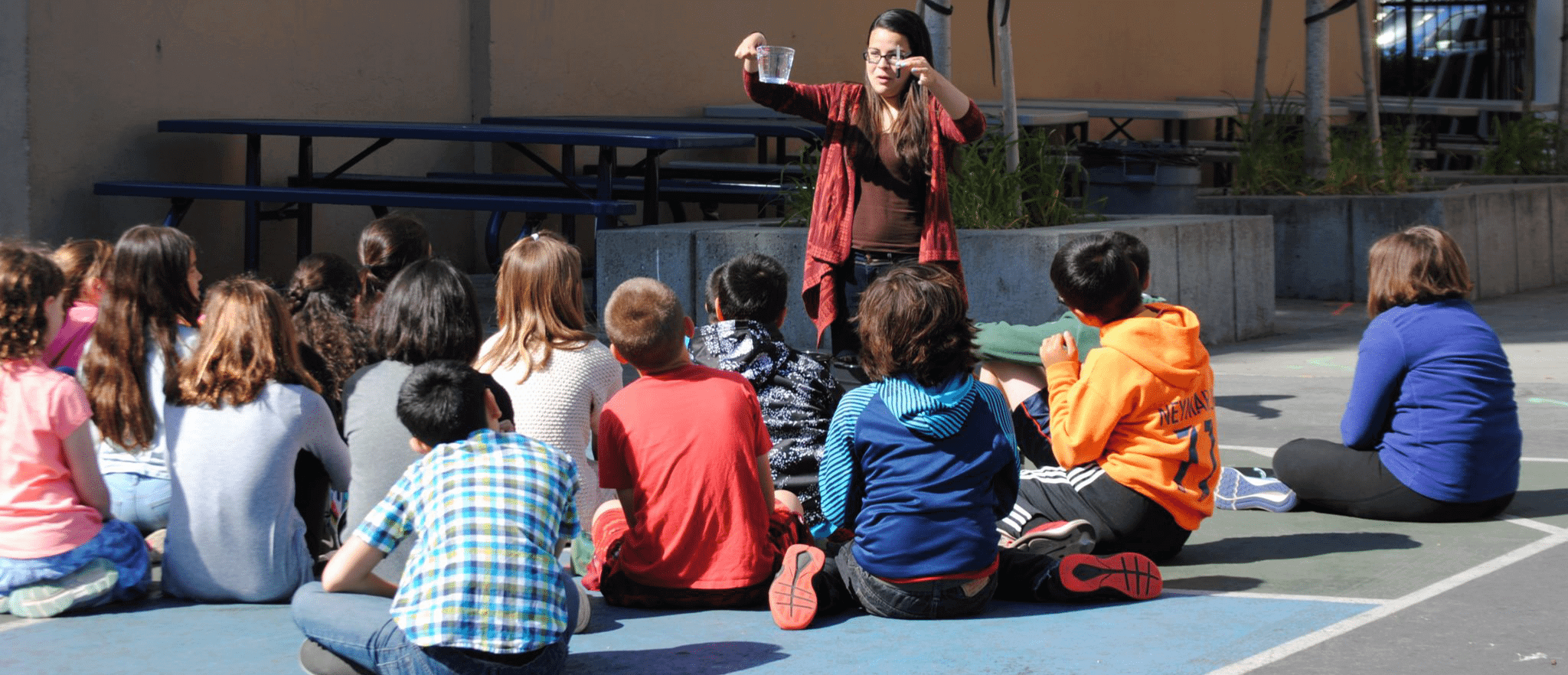
Or Jose Flores, a high school teacher at Brawley Unified School District, who reports how students might use this education: “Students can truly have a voice, and express that voice by attending school board and city council meetings to engage in civil discourse with their elected officials to enact positive change in their community in addressing social and environmental issues.”
Those testimonials are validation of both the California Common Core State Standards and the CA-NGSS which emphasize the importance of student-centered instruction, hands-on learning, and real-world learning experiences. Environment-based science and history–social science education using engaging local contexts offer a powerful entry point for such experiences that students never forget.
In sum, we know this is hard work even without the misinformation campaigns working against us or the fact that we’re starting all of this too late to educate the last generation of voters, consumers, educators, and activists who might have prevented some of the impacts of climate change and species extinction that we are already witnessing. There are no shortcuts, but California and LDF have given you tools, and we hope you will use them.
Shakespeare wrote, “There is a tide in the affairs of men, which, taken at the flood, leads on to fortune.” I pose to you that we are upon such a sea at this moment and it is only ecoliteracy that can help everyone understand this tide and shape our future…before it shapes us. And I believe that you are our champions who will teach the next generation to do just that. Thank you!

